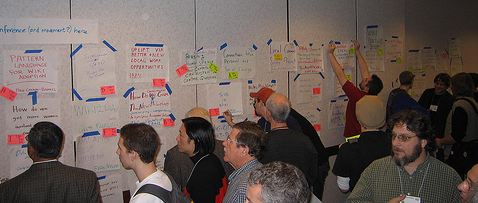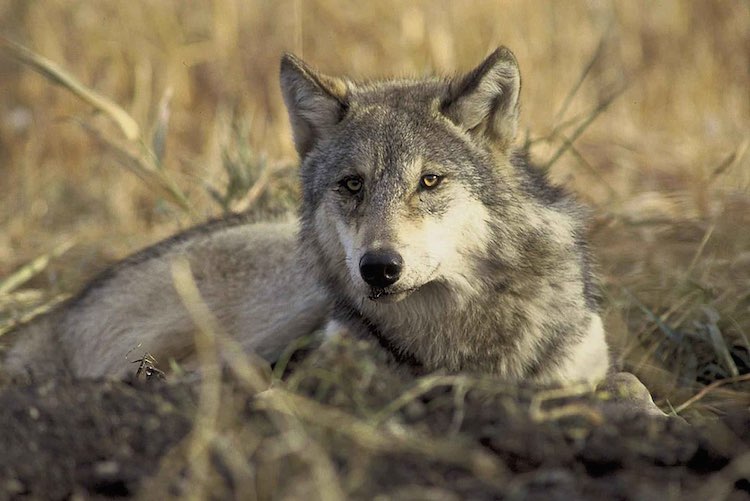Decrease of American Women Smoking
U.S. Forests Expanding
Since 2000, U.S. forests have expanded by an area larger than Delaware. — Jan. 2006, Smithsonian magazine
Sudan and Chad Agree to Peace Plan
 Sudan and Chad have agreed to end a crisis that began last year when fighting broke out on their border, reports BBC News.
Sudan and Chad have agreed to end a crisis that began last year when fighting broke out on their border, reports BBC News.
“After months of dispute, the Tripoli accord, chaired by Libyan leader Muammar Gaddafi, commits the two countries to restore diplomatic relations and cease any attempts of cross-border conflict,” said the February 9 report.
“I was blind for 25 years. Had a heart attack, woke up and could see.”
 From the Telegraph newspaper in the UK, comes this story of a woman who had been blind for 25 years and awoke in the hospital after suffering a heart attack with her sight fully restored! The first thing she said to her husband — after, “I can see, I can see” — was, “You’ve gotten older haven’t you?”
From the Telegraph newspaper in the UK, comes this story of a woman who had been blind for 25 years and awoke in the hospital after suffering a heart attack with her sight fully restored! The first thing she said to her husband — after, “I can see, I can see” — was, “You’ve gotten older haven’t you?”
Lower Lead Levels in U.S. Kids
Water for Life
He remembers how the people reacted when he came to drill a well for them. “People just mobbed me and cried.”
Willis Miller believes in fate. Near death with a heart attack at age 50, he vowed to spend the rest of his life doing good in the world if he survived.
Now 81, Miller can take satisfaction in the decades of good created through his nonprofit organization, Water for Life. Miller spent all the money he saved as a successful water well driller to provide and maintain hundreds of water wells for the poor in Haiti, many of whom walked over 5 miles for a bucket of dirty water. “If you don’t have clean water,” Miller said, “you don’t have anything.”
Water for Life provides clean water for over 200,000 people a day in Haiti. Clean water not only improves health, but crop production and living conditions as well.
While recovering from his heart attack, Miller met a man one day who asked him what he did for a living. “I told him I was a water well driller, “ Miller said. “This man started telling me about how bad it was in Haiti, how a Haitian mission had a water well that no one could fix.”
For the next seven years Miller gave his time and expertise to large organizations such as World Vision and Compassion International. He remembers how the people reacted when he came to drill a well for them, “People just mobbed me and cried.”
The large organizations didn’t service the wells once they were drilled. “It just didn’t work out,” Miller said. “I drilled over 40 wells for them, but today none of them are working.”
Miller became so frustrated he was ready to return to his home in rural Iowa. But a friend decided he would rent out his farmland and give Miller the money so that he could continue his good works in Haiti. “We started with nothing,” Miller said, “but today Water for Life has a budget of over $600,000 and has more than 300 working wells in Haiti.” Water for Life trains Haitians to service the wells. A single well provides clean water for about 750 people and 250 livestock.
Water for Life also built two irrigation systems, a church and a primary school in Haiti. Before the irrigations systems were put in, Miller said, crops baked in the sun and yielded little edible food. “They used to get a bushel of corn. Now they get a roomful of corn,” Miller said.
Although he retired about 5 years ago, Miller remains involved in the operation of Water for Life from his home in Kalona, Iowa. His son, Leon, now president of Water for Life, spends much of his time in Haiti conducting most of the work, Miller said. “I feel I’ve accomplished what I set out to do,” he said. Seeing the living conditions in Haiti change dramatically has been one of Miller’s greatest rewards.
Miller said, “Mothers would tell me their babies once had worms up to three feet long, but not any more.” Then he smiled, “That just thrilled my soul.”
Mayors Combat Greenhouse Gases in US
States Set Renewable Energy Goals
Eighteen states, including power hogs California and Texas, have set requirements or goals for renewable energy. New York, for one, aims to generate 25 percent of the state’s energy from renewables by 2013, up from 19 percent today. (Jan. 2006)
The Legend Of Bagger Vance
An Inspired! Book Review
Bagger Vance is a wonderfully inspiring story that uses the quest of mastering ones golf swing as a metaphor for mastering ones self and ones existence.
The author, Steven Pressfield, weaves his tale using the unfolding lives of three men from three generations. Each man struggles to let go of emotional scars that haunt and torment his life. It is after each one reaches his lowest point that the presence of a mystical being, Bagger Vance, appears in the guise of a golf caddy to reveal a path that leads to greatness and self mastery.
The book is loosely based on the Bhagavad-Gita, the ancient Hindu epic and spiritual text of India. Bagger Vance represents the divine being that appears as a guide offering insight on how to live an authentic life.
The internal fight that each man faces is played out through his golf game. But the teaching here is not only about the golf swing. . .
Golf is just the perfect vehicle for Pressfield to convey a deeper message, that each of us is meant to stand up, explode into our existence, surrender to it completely, and be (without guilt or pride) all of what we can be. This is what is meant by mastering one’s self.
Bagger Vance will not only appeal to every athlete or performer, it is truly for everyone. Everyone has a game, an arena, or field in which they play. We all were meant to excel. It is up to each of us to find the field, know the field, and be the field. Reading this book will inspire you to do all three.
See the book or movie
Honoring Youth Heroes
 June 3, 2005 — Kids everywhere are helping out around communities. These children have done things such as volunteering, raising money for patients with cancer, even helping out at the local YMCA. Whatever the reason may be, whether it’s to help the ill or just to put a smile on someone else’s face, it’s nice to know that children can make a difference in the world.
June 3, 2005 — Kids everywhere are helping out around communities. These children have done things such as volunteering, raising money for patients with cancer, even helping out at the local YMCA. Whatever the reason may be, whether it’s to help the ill or just to put a smile on someone else’s face, it’s nice to know that children can make a difference in the world.
“This year North Star was overwhelmed by nominations for the award,” Lindsey Murtagh, manager of the North Star Program, said. “I think it is a tribute to our youth (aged 6–17) that we received so many stories detailing their heroic efforts. Our community is built on the efforts of unsung heroes.”
A Massachusetts community honored its young heroes in the annual North Star Hero Awards. Amber LaFountain, a youth leader in the Brayton Hill neighborhood, was chosen one of the area’s finest volunteers. For the past five years, the Northern Berkshire Community Coalition has been able to count on this important volunteer to help organize and lead activities in the neighborhood and wider community, including last summer’s Voter Awareness project, National Night Out, and dozens of other special projects, all of which benefited from her leadership abilities.
![]() tells the story of five more young heroes, including six-year-old Justin Beany, who participated in a program called Pennies for Patients.
tells the story of five more young heroes, including six-year-old Justin Beany, who participated in a program called Pennies for Patients.
“On his own initiative he asked his parents if he could do chores to earn pennies. He vacuumed, washed dishes, emptied the trash, swept the kitchen, cleaned his room and made his bed” to earn money to help sick children.
Humanitarian Video Game Surprise Hit with One Million Players
Humanitarian Video Game Surprise Hit with One Million Players

Launched by the United Nations last summer, the first video game designed to teach children about global hunger has surpassed all expectations in the gaming world by reaching more than three million players in 40 countries.
Surprisingly, the game, “Food Force,” released by the UN World Food Programme features no guns and no aliens. Instead, kids race against time to feed thousands of people on the fictitious island of Sheylan, alongside a team of emergency aid workers.
They pilot helicopters while looking out for hungry people, negotiate with armed rebels blocking a food convoy, and use food aid to help rebuild communities.
“Finally! An educational game that rocks!” comments Watercoolergames.com. Along the way, gamers learn about the real world where over 800 million people are plagued by hunger each day.
Available as a free download in MAC and PC formats through a dedicated website where information on global hunger can also be found, the world’s first humanitarian video game contains six different missions aimed at children 8-13 years old. Evidence of the response to the game includes thousands of comments posted on the site along with highest scores.
As of today, “manchild85 (JWH)” of the United States leads with a high score of 60,000,000 points.
According to John Powell, WFP Deputy Executive Director, the game is reaching 40 countries even though it is currently available in English only. Powell is looking for partners to help translate the game into other languages.
The WFP is also focusing on free distribution in schools around the world, backed by Yahoo! and Internet2, a Washington-based high-speed educational network. In addition, the game is supported by a community web site which includes lesson packs on world hunger in seven languages provided by the UN Food and Agricultural Organization
Reintroduction of Wolves Into Yellowstone Brings Wildlife Back Into Balance
 One of the greatest environmental success stories in history is playing out on the landscapes of the rural West.
One of the greatest environmental success stories in history is playing out on the landscapes of the rural West.
When wolves were reintroduced into Yellowstone and Northern Idaho in the mid-1990s, the ecological ideas of how large predators affected ecosystems, and the conservation policies that could support predator restoration, were mostly theory. Now, ten years later, grounded knowledge has replaced theory, and the wolf stands out as one of the greatest environmental success stories in history.
Prior to wolves, the elk numbers in Yellowstone had been growing dramatically, and burgeoning populations of sedentary elk were severely overgrazing the native landscape.
When wolves returned and started chasing elk, many other changes followed. Willows grew higher and spread more widely, beavers returned and made ponds, riparian-dwelling plants and animals returned—including songbirds and trout—elk carrion fed scavengers such as grizzlies and ravens, and coyote populations dropped resulting in more ground squirrels and gophers, which in turn fed hawks and eagles.
Wolves have also nudged the behavior and life-histories of other animals back into their natural evolutionary course. Without wolves, the system continued to simplify and fragment, and each species’ evolutionary course was stunted; with wolves, that course has realigned.
The elk in Yellowstone, for example, have changed over the last ten years since the wolf’s return. They now live shorter lives, they move around more, and they are more vigilant. They have become what they used to be — wild elk. When the wolf fails to chase the elk, the elk and everything around it becomes something different, something more singularly caused by humans instead of by the myriad factors in natural evolution.

But even in the face of this less hospitable climate, a surprising thing has happened in the Northern Rockies: wolf tolerance from rural landowners is increasing, and wolf numbers are growing dramatically.
After listening intently to the legitimate concerns of ranchers, the nonprofit group Defenders of Wildlife created a program that compensates ranchers for livestock lost to wolves. Defenders has another program that builds fences, buys guard dogs, and pays for other proactive tools that promote wolf recovery. Given the success of these two programs, a few states (including Colorado) are considering similar incentives..jpg)
Gary Wockner is one of fourteen people who is charged with developing a management plan for wolves in Colorado. He’s spent a significant amount of time studying the role wolves will play in our ecosystem, human attitudes about wolves, and wolf conservation programs. (Top photo by Retron, CC license)
Bald Eagle Numbers Soar
 USA Removing Eagle from Endangered Species List
USA Removing Eagle from Endangered Species List
After nearly four decades on the endangered species list, bald eagles are soaring once again, their population climbing from a dismal count of just 417 nesting pairs in the continental United States in 1963 to more than 7,000 today.
With an additional bounty of tens of thousands of the majestic raptors thriving in both Alaska and Canada, the U.S. Fish and Wildlife Service announced in February that it was taking steps to follow President Bill Clinton’s 1999 recommendation to remove bald eagles from protection under the Endangered Species Act.
Despite delisting, two other laws will continue to ban intentional harm to America’s national bird: the 1918 Migratory Bird Treaty Act and the 1940 Bald Eagle Protection Act.
The United States government came to the eagle’s rescue in 1940 with the belief that eagles were in trouble even though the actual population was unknown. Congress passed the Bald Eagle Protection Act making it illegal to kill, harass, possess, or sell bald eagles. “The bald eagle is no longer a mere bird of biological interest but a symbol of the American ideals of freedom,” the law states.
However, the act did not protect the birds from environmental threats, such as the widespread use of DDT and other pesticides after World War II or from lead shot. Eagles ingested large quantities of leftover lead when they ate waterfowl wounded by hunters. Effects in the nest include reduced egg numbers and weakened shells to the point that many would break before chicks could hatch.
In 1973 the bald eagle was one of the first species afforded the full protection of the American government under the new Endangered Species Act. Intentional harm and harassment were banned and habitats protected from further damage and encroachment. In 1972, the Environmental Protection Agency outlawed DDT and in 1991, the use of lead shot in hunting waterfowl, a component of the eagles’ diet, became illegal. An aggressive captive breeding program by USFWS boosted rebounding populations assuring for future generations the prominance of this soaring bird in the American landscape.
related links:
Saving The Earth With Help From Above
The European Space Agency (ESA) agreed to launch a copy of its lost Cryosat Satellite to definitively measure the effect of climate change on Earth’s ever-changing ice sheets.
The first Cryosat Ice mission was launched last October from the Plesetsk Cosmodrome in northern Russia, but was lost when the second stage of its launcher failed to separate. The rocket plunged into the ocean with Cryosat aboard. Cryosat chief scientist Duncan Wingham, however, was undaunted, rallying his supporters behind his firm conviction that “Cryosat is too important to lose.”
Wingham lobbied for funding and on February 24 the ESA Programme Board agreed to provide over one hundred million euro to launch Cryosat-2, a satellite that will measure and monitor the health of land and sea ice worldwide.
Cryosat-2 could launch in as little as three years on a mission to help explain the complex relationships between the polar ice, the rise in sea levels, and climate change. Cryosat-2 is the first in a series of missions called Earth Explorers, part of ESA’s Living Planet Program to launch low cost spacecraft to help us to understand the Earth, and our impact on it.
CHECK OUT: Scientists Confirm Victory in Ozone Layer Recovery
Another mission will launch this year to accurately map the world’s gravitational fields. While gravity feels constant to people, Earth’s gravitational field actually varies widely from place to place. The Gravity (GOCE) Earth Explorer will provide an accurate map to help explain the effects of gravity on ocean currents that regulate the climate from place to place, keeping Europe warm and Antarctica cold, for example. Goce will also be able to effectively monitor sea level rise, and the effects of gravity on surface water flow, helping us to predict climate changes and the need for sea barriers and levees. (Photo credit: ESA)
Open Space Conference Draws Technologists and Social Activists Together to Build Better Communities
 Feb. 5, 2006 — A conference to advance the use and technology of wikis and other community-building tools provided the perfect setting to try out the Open Source style of conference called Open Space, which is based upon spontaneous creative collaboration.
Feb. 5, 2006 — A conference to advance the use and technology of wikis and other community-building tools provided the perfect setting to try out the Open Source style of conference called Open Space, which is based upon spontaneous creative collaboration.
That meant that when more than 100 participants arrived in Portland, Oregon, on Friday for the three day event, no schedule, no agenda, and no speakers were on any program. Instead, attendees proposed dozens of topics for small group discussions by announcing and then posting on a wall their proposed sessions, with an attached room number and time. Social activists and software engineers co-mingled in front of the wall searching for the sessions that would fulfill their desires and potential as participants. The conference was called Recent Changes Camp, a name befitting the bustling free-for-all environment.
St. Paul: Whatever is lovely, thing about these things…
Whatever is true, whatever is noble, whatever is right, whatever is pure, whatever is lovely, whatever is admirable — if anything is excellent or praiseworthy — think about these things.
Washington Post ombudsman thinks about their impact
Are we supposed to be boosters or promoters? What are we supposed to be? Not destroyers of community; not extinguishers of hope. We need to think about our impact. We tend to say we don’t have one; we just pass along the news. Readers say otherwise.
Mark Gerzon
A media diet of hostility, blame, confrontation and violence corrodes your civic outlook.
Norman Cousins
If news is not really news unless it is bad news, it may be difficult to claim we are an informed nation.
Marianne Williamson
I think the press, including TV journalism, has an ethical responsibility, a sacred responsibility, a service mission … to make good news just as entertaining (as we’ve made sexy the violence).






















